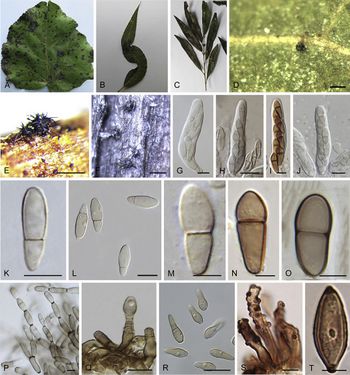Maintenance
All wikis at Biowikifarm are in read-only mode due to the restoration after a severe cyberattack in October 2023.
After 1 year being shut down the Biowikifarm is online again.
You see the latest restored version from 18th October 2023.
Venturia (genus)
| Literature database |
|---|
| 504 articles sorted by: |
| • year (descending) |
| • research topics |
| • countries/regions |
| • host plants |
| • list of antagonists |

Author(s): Y. Marin-Felix, J.Z. Groenewald, L. Cai, Q. Chen, S. Marincowitz, I. Barnes, K. Bensch, U. Braun, E. Camporesi, U. Damm, Z.W. de Beer, A. Dissanayake, J. Edwards, A. Giraldo, M. Hernández-Restrepo, K. D. Hyde, R. S. Jayawardena, L. Lombard and P.W. Crous
Source: Studies in Mycology (2017), vol. 86, p. 204
Venturia Sacc. 1882
This genus of plant pathogenic fungi is common in temperate regions. The species spread by airborne ascospores or asexual conidia. The sexual ascomata are small, immersed and usually have setae. The ascospores are ovoid or ellipsoid, brownish when mature, with 2 cells.
A number of species are significant for agriculture and forestry, causing scab diseases, leaf and shoot blight, or leaf spots. The scab causing species are economically most important and include, for example:
- Venturia carpophila (peach scab)
- Venturia effusa (pecan scab)
- Venturia inaequalis (apple scab)
Type species: Venturia inaequalis
For a taxonomic review of the genus see Marin-Felix et al. (2017).
Currently, the following species have been entered into the system: